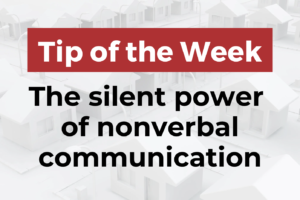
In the dynamic and fast-paced realm of real estate, agents often navigate a complex web of communication with clients. One critical aspect that can be overlooked is the wealth of nonverbal cues, especially in a landscape where initial interactions frequently occur over the phone before progressing to face-to-face meetings. Research indicating that 55-65% of communication is nonverbal underscores the importance of honing in on these cues for real estate agents. Being aware of this, not only gives you clarity on who you should spend your valuable time with, but can also help you uncover hidden concerns or preferences that may not be explicitly communicated.
- Phone Conversations: With the majority of initial client interactions occurring over the phone, you must be aware of the subtle nuances of vocal tone, pacing, and inflection.
- Building Trust: Trust is paramount in real estate relationships. Nonverbal cues like a warm and engaging tone, coupled with active listening skills, can create a positive impression and lay the foundation for a strong client-agent relationship.
- Face-to-Face Interactions: As conversations progress and transition to face-to-face interactions, you must be adept at reading in-person nonverbal cues. While you are talking to them, are they slouching, distracted, avoiding eye contact, turned away, etc.? Body language during meetings, tours, and negotiations can reveal a client’s genuine interest, concerns, or hesitations, guiding the agent in tailoring their approach.
- Utilizing Technology: Technology bridges the gap for visual communication even in remote interactions, like through Zoom or FaceTime. Leverage this technology.
As agents navigating the fast-paced and competitive industry, understanding the silent language of nonverbal communication is a game-changer. Whether on the phone or in person, being conscious of vocal cues, body language, and facial expressions can enhance client interactions, build trust, and ultimately contribute to successful client-agent relationships and transactions. Developing an awareness of both verbal and nonverbal aspects of communication empowers agents to navigate the complexities of client relationships with finesse and efficacy.

